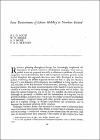| dc.contributor.author | Roche, D.J.D. | |
| dc.contributor.author | Birrell, W.D. | |
| dc.contributor.author | Murie, A.S. | |
| dc.contributor.author | Hillyard, P.A. | |
| dc.date.accessioned | 2014-04-24T15:49:15Z | |
| dc.date.available | 2014-04-24T15:49:15Z | |
| dc.date.issued | 1973 | |
| dc.identifier.citation | D.J.D. Roche, W.D. Birrell, A.S. Murie, P.A. Hillyard, 'Some determinants of labour mobility in Northern Ireland', Economic and Social Research Institute, Economic and Social Review, Vol.5 (Issue 1), 1973, 1973, pp59-73 | |
| dc.identifier.issn | 0012-9984 | |
| dc.identifier.uri | http://hdl.handle.net/2262/68972 | |
| dc.description.abstract | Recent planning throughout Europe has increasingly emphasised the importance of growth centres in development strategies. New and expanded towns are proposed not solely as solutions to problems of overspill, congestion and re-development but as aids to regional economic growth. In the United Kingdom this approach has been most fully developed in Northern Ireland. Following the Belfast Regional Survey and Plan in 1964 (the Matthew Report)1 a new Ministry of Development was established to bring together what was described as the key functions of infrastructure, planning, development and local government. | |
| dc.language.iso | en | |
| dc.publisher | Economic & Social Studies | |
| dc.relation.ispartofseries | Economic and Social Review | |
| dc.relation.ispartofseries | Vol.5 (Issue 1), 1973 | |
| dc.subject | Labour mobility | |
| dc.subject | Northern Ireland | |
| dc.title | Some determinants of labour mobility in Northern Ireland | |
| dc.type | Journal Article | |
| dc.status.refereed | Yes | |
| dc.publisher.place | DUBLIN | |
| dc.rights.ecaccessrights | OpenAccess | |
| dc.format.extentpagination | pp59-73 | |




